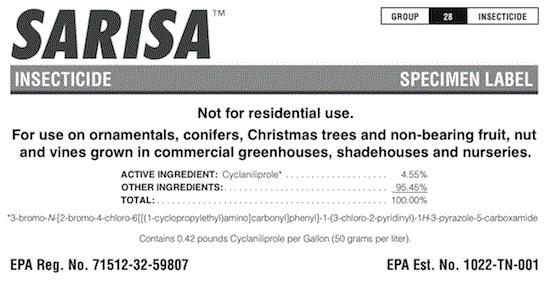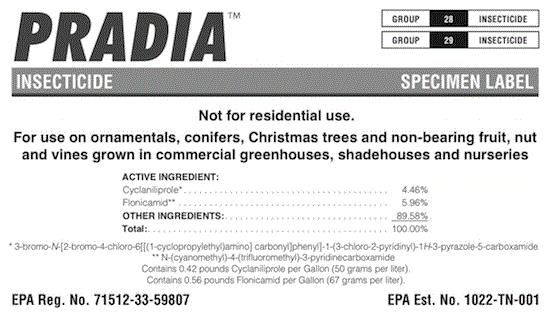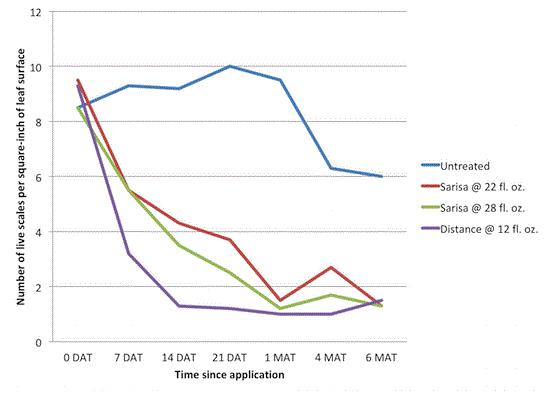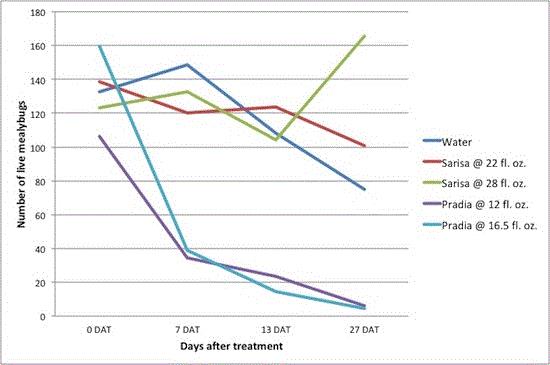A new and improved PestTalks?
I promised y’all something on scale insects, but I’ll have to fulfill my promise in the next issue. This week, OHP introduced two new insecticides, which I’ll devote this issue to.
In the past, I only introduced new pesticides or pest management products without much, if any, commentary on their efficacy. I’m sure y’all are tired of me talking only about the introduction of new insecticides or fungicides—the same information you can get from the multitude of trade magazines and newsletters you receive in physical and digital mailboxes. You are probably saying, "Enough already! Tell us something we can't get anywhere else but this newsletter!" Well, you are right. The value of this newsletter is in giving you more in-depth and relevant information about pest management than what other sources can. I’ve always given lots of information in my long-winded presentations (hence the very anxious moderators and the glassy-eyed audience), so why can't I do it here?
Starting with today’s issue, I’m going to change my style a bit and share with you my research experience whenever I have data on insecticide and miticide efficacy, and recommendations on use. I don’t have first-hand trial data on fungicides or herbicides because, you know, I work with bugs only. But, I will find the information you’ll need to make the best pest management decisions. Finding all the details may take a little bit of time, but I’ll find it. Sometimes, the discussion will be long; sometimes, it will be short. Some of what I say may be flattering of a new product; some won't. Sometimes, the topics are relevant to you; sometimes they ain’t. Sometimes I’ll make people happy; sometimes I won't. Sometimes, it will cost me a Christmas card and sometimes I’ll earn a new friend. I can live with that.
Despite the attention-grabbing headline, this is still the PestTalks you know. I’ll still be stumped in “What the … ?”, and I’ll still give you management information on various pests, diseases and weeds. You’ll still see me make a fool of myself on my soapbox. And, you’ll still get information on new products, only now you’ll get more than mere press releases.

OHP introduces Sarisa and Pradia insecticides
Sarisa and Pradia insecticides are now available to nursery and greenhouse growers in the U.S. Sarisa contains a brand new active ingredient, cyclaniliprole. Pradia contains two active ingredients—cyclaniliprole and flonicamid. (Flonicamid is the active ingredient in Aria.)
I might not look the part, but I’m a pretty excitable guy. Doubly so when a new active ingredient is introduced. That often means I have more toys to play with (safely and with all my PPE).
Cyclaniliprole is in IRAC Group 28—the ryanodine receptor modulators. Ryanodine receptors are little calcium channels located on muscle cells and neurons, and through the release of calcium ions, play a critical role in muscle contractions. Group 28 insecticides over-activate the ryanodine receptors, and lead to uncontrollable contractions and paralysis. Chlorantraniliprole (Acelepryn) and cyantraniliprole (Mainspring) belong to this group. Additional members may be introduced to Group 28 in the near future.

Sarisa and Pradia are registered for use on ornamental plants, conifers and non-bearing fruit and nut trees grown in greenhouses, shadehouses and nurseries. Target pests include leaf-feeding caterpillars, beetles and thrips, as well as sucking insects (adelgids, aphids, lace bugs, mealybugs, psyllids, soft scales, stink bugs and whiteflies), borers (beetle and caterpillar), leafminers, midges, root weevil adults and sawflies. Use rates range from 10.9 to 27 fl. oz. per 100 gallons for Sarisa, and 10 to 17.5 fl. oz. per 100 gallons for Pradia. While Sarisa achieves suppression of mealybugs and foliage-feeding thrips, the addition of flonicamid in Pradia allows for better control of thrips and mealybugs, as well as plant bugs. Although their kissing cousin, Mainspring, can be applied as a drench, Sarisa and Pradia can only be applied through foliar sprays at this time.

With support from the IR-4 Project, I had the opportunity to evaluate the efficacy of Sarisa (when it was called IKI-3106) against tea scale in 2015, western flower thrips in 2016, and redheaded flea beetle and chilli thrips in 2017. All of the trials were conducted in outdoor nurseries. Several colleagues also conducted trials to evaluate the efficacy of Sarisa and Pradia throughout the country. I'll try to summarize some of these trials in the next segments.
Trials in which Sarisa wasn't successful
I conducted an experiment in 2016 to evaluate the efficacy of Sarisa against western flower thrips feeding on verbena flowers grown in an outdoor nursery. Sarisa was applied at 22 or 27 fl. oz. per 100 gallons, with each rate applied three times on a biweekly basis, or five times on a weekly basis. A spreader-sticker, CapSil, was added to the solution as an adjuvant. The efficacy of Sarisa was compared to Avid. Neither Avid nor Sarisa was effective in reducing adult and immature thrips numbers and damage when compared to the water-treated control.
Erfan Vafaie of Texas A&M AgriLife Extension, who also received support from the IR-4 Project and evaluated the same treatments against western flower thrips on marigolds grown outdoors, also reported similar results.
An OHP product information brochure for Sarisa cited a study by Ray Cloyd of Kansas State University, evaluating the efficacy of Sarisa against western flower thrips. In that study, Sarisa applied at 16.4 fl. oz. per 100 gallons achieved greater mortality of western flower thrips than Mainspring applied at 4 or 8 fl. oz. per 100 gallons.
I conducted a trial in 2016 against chilli thrips, and used Avid as standard for comparison. Sarisa was applied at 22 or 27 fl. oz. per 100 gallons and each rate was applied three times at 14-day intervals, or five times on a weekly basis. Although chilli thrips are foliage-feeding thrips, I didn’t detect significant reduction in chilli thrips numbers or damage on plants treated with Sarisa or Avid when compared to the water-treated control throughout the 50-day experiment. Again, I think the treatments failed because thrips pressure was so high that they didn't stop trying to attack the plants.
The last of my trials with Sarisa was on redheaded flea beetle. Sarisa was tested at only one rate (22 fl. oz. per 100 gallons; twice at 14-day intervals), and compared to Scimitar GC (at 5 fl. oz. per 100 gallons; three times on weekly basis). Although Sarisa and Scimitar killed the adult redheaded flea beetles feeding on the paniculate hydrangea foliage at the time of the application, the insecticide residue didn't reduce the number of beetles in subsequent infestations, nor did it reduce defoliation. In other words, Sarisa- and Scimitar-treated plants were as severely defoliated as the water-treated control.
I have to repeat this: the pest species I’d pitted Sarisa against are real pain-in-the-you-know-whats, right up there with mealybugs. There are tons of thrips and redheaded flea beetles in the environment, and they seem quite tolerant of insecticide residue—these beasts come back as soon as the effective repellency of insecticide residue wanes. Even if the residue kills them, there are so many thrips and flea beetles around that there’ll always be several that are willing to try a bite. Those few can still cause damage before the effects of insecticides set in.
Sarisa alone didn't appear to be effective against western flower thrips in my trials. I think the label language of "suppression" is prudent. I think Sarisa should be a part of a rotation program or a component of a tank mix when it comes to managing these tough pests (see the efficacy of Sarisa against mealybugs in the next segment).

Trials in which Sarisa and Pradia were successful
Also with support from the IR-4 Project, Karla Addesso of Tennessee State University conducted a trial to evaluate the efficacy of Sarisa against adult Japanese beetles feeding on crape myrtles and roses. Sarisa was applied at 22 and 27 fl. oz. per 100 gallons, and TriStar 8.5 SL was applied at 25.3 fl. oz. per 100 gallons. All treatments were applied twice at 14-day intervals. Japanese beetle lures were placed in the crape myrtle plots to attract the beetles to the treated plants, while 100 adult beetles were introduced to each cage containing the treated roses. The open field study didn’t detect any reduction in defoliation on Tristar- or Sarisa-treated crape myrtles, when compared to the water-treated control. In the cages, however, roses treated with Tristar and Sarisa at 27 fl. oz. per 100 gallons suffered significantly lower levels of defoliation than the water-treated control at 14 to 28 days after treatment.
I conducted a trial in 2015 to evaluate the efficacy of Sarisa when applied three times at 14-day intervals at 22 and 28 fl. oz. per 100 gallons, against tea scales on Buford holly. Remember that the high label rate of Sarisa is 27 fl. oz. per 100 gallons, and that armored scales are not target pests of Sarisa. The efficacy of Sarisa was compared to Distance, applied twice at 21-day intervals at 12 fl. oz. per 100 gallons. Both Sarisa and Distance reduced the numbers of live scales (per square-inch area) compared to the water-treated control. Distance achieved significantly faster reduction in scale insect densities than Sarisa in the first month after treatment. Sarisa caught up to Distance after the first month, and continued to maintain a low live scale population until six months after treatment. The two rates of Sarisa were similar in efficacy. I think Sarisa is successful in this case because it was applied against crawlers, the life stage when scale insects are most vulnerable to insecticides.

The average number of live tea scales on holly plants treated with Sarisa (at two rates) and Distance IGR. DAT = days after treatment; MAT = months after treatment.
I don't have any trial experience with Pradia, but I’ll have some soon! Carlos Bográn (technical manager at OHP) and I are going to collaborate to look at the efficacy of Pradia against mealybugs. Y’all know how tough those buggers are. Please let me know if you’ve always been successful in managing mealybug infestations. I’ll put your name up on this newsletter and you’ll be the most well-known green industry professional in this country. (Well, at least to the 25,000 subscribers of this newsletter. You’ll have a bigger audience when Bossman Beytes and editors from other magazines put you in front of the entire world!)
Anyway, I’ll update you once I get the trial started this summer and when research data pours in. In the meantime, you’ll just have to be satisfied by trial results from my other colleagues.
One such trial was conducted by Dan Gilrein of Cornell Cooperative Extension of Suffolk County, with support from the IR-4 Project. Dan evaluated the efficacy of Sarisa (22 and 28 fl. oz. per 100 gallons, twice at 14-day intervals), Pradia (12 and 16.5 fl. oz. per 100 gallons, twice at 14-day intervals) and other products against the Madeira mealybug on coleus. While Sarisa didn't impact mealybug survival, both rates of Pradia significantly reduced the numbers of live mealybugs compared to the water-treated control plants (by 94% at 27 days after treatment). Both rates of Pradia performed equally well. The addition of flonicamid in Pradia has improved the efficacy of the product when compared to Sarisa alone.

The average number of live Madeira mealybugs on coleus plants treated with Sarisa and Pradia. DAT = days after treatment.
What does JC think about Sarisa and Pradia?
Typical of many pesticides, Sarisa and Pradia performed well against some pests but not others. Researchers had given the two products their toughest bugs under the toughest conditions.
Sarisa is labeled as "suppression" for thrips and mealybugs. This is backed up by several trials that have shown varying degrees of efficacy of Sarisa, even against the same species, such as western flower thrips. If you choose to use Sarisa against these pests, I suggest that you consider hitting the pests when they are most vulnerable (such as during crawler emergence for scales and mealybugs), or using Sarisa as part of an overall, multi-pronged management program. When appropriate, Pradia will likely give greater efficacy against some pests, such as thrips and mealybugs, than Sarisa.
I encourage you not to just listen to my stories, but also to study my colleagues’ research. Also, talk to the folks at OHP. Most importantly, try Sarisa and Pradia yourself. You just might say, “Gah! Sarisa is awesome against thrips. That JC is full of ____!”






See y'all next time!

JC Chong
Professor of Entomology at Clemson University
This e-mail received by 25,257 subscribers like you!
If you're interested in advertising on PestTalks contact Kim Brown ASAP!